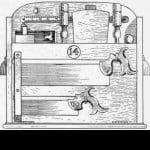Making Winding Sticks
Welcome! / Forums / General Woodworking Discussions / Making Winding Sticks
- This topic has 27 replies, 18 voices, and was last updated 10 years, 10 months ago by
 mikeprutz.
mikeprutz.
-
AuthorPosts
-
 4 February 2013 at 2:39 am #7391
4 February 2013 at 2:39 am #7391My winding sticks are store bought from Lee-Valley. They’re made of extruded aluminum and are 18″ long. If I were making my own I’d stick with the 18″. As long as you have some contrast you’ll be okay. I like the LV sticks because they have grooves in them to give you an estimate of the amount of twist. No reason you couldn’t do something similar if you wanted the reference.
http://www.leevalley.com/US/wood/page.aspx?p=53276&cat=1,230,41182

 4 February 2013 at 5:06 am #7393
4 February 2013 at 5:06 am #7393Mine are 24″, and I like that length, maintained properly by the occasional match jointing they also make a handy straight edge for marking lines or checking boards when they are closer to hand than the regular straight edge.
 4 February 2013 at 10:56 am #7397
4 February 2013 at 10:56 am #7397There’s no real ideal size for winding sticks, as far as I know. Apart from needing to be longer than the board is wide, the longer they are the more they will exaggerate any twist in the board. There are obviously practical limits on their size though – a pair of 4′ long sticks will show any twist really well but you might not be able to maneuver them in the shop!
George.
 Anonymous4 February 2013 at 2:24 pm #7406
Anonymous4 February 2013 at 2:24 pm #7406Gary
I also use the aluminium winding sticks from Lee-Valley.
The machined grooves are spaced 1/8″ apart to help estimate the amount of twist and how much stock to remove. The two 18″ long sticks nest together and have hanging holes for easy storage, they work just fine and stay true. 4 February 2013 at 8:27 pm #7422
4 February 2013 at 8:27 pm #7422Woodpeck.com (Woodpeckers) had a one-time tool order for 7 – 23 – 47 inch sticks. A bit expensive too. They have a video on their site.
As far as I knew, winding sticks were not manufactured and sold as a retail item. everyone made their own. Woodpeckers was the first that I know of to try to retail them. Then I saw Lee Valley came out with theirs.
If you want to make your own, Jim Tolpin has a book “The New Traditional Woodworker: From Tool Set to Skill Set to Mind Set ” that has instructions on making your own along with other things like tri-squares, etc..
Lastly, for those who are “frugal” blue painter’s tape on each end of one of the winding sticks provides quite alot of contrast so you don;t have to buy a more expensive species of wood just to get contrast – but, then agian, I like tools that are functional but also look great. If you want only functional because you will make them quick for a one off use……
Jim


Ken, you are very quick with the helpful links. Good job.
Most vintage ones I’ve seen for sale over the past 3 years have been about 16-18″ long. I probably would not go any shorter than that, but would go longer if you have the room to spare. If wood, I think quarter sawn stock would be a must.
I have a 24″ pair I made a few years back out of dense, quarter sawn doug-fir. I used one of them this past weekend to help me level out my jointer’s out feed table and knives. Worked like a charm. No need to order an expensive straightedge from Lee Valley.
I also have two lengths of 1/8″ extruded aluminum angle cut from a single 36″ piece that is remarkably stiff and flat. A bit of dye or carefully placed electrical tape would give you plenty of contrast.
Anonymous5 February 2013 at 12:52 am #7448HaHa Scott, your timing is spot on buddy, and you have just restored my faith in forums. I was just thinking to my self, why do I bother post on forums. I have stayed away from them for years, despite being a moderator on a none woodworking forum.
Its always the same people do there best to help, and most members cant even bother there ass to reply even in there own thread. There is nothing worse than someone posting and no one has the manners to take 30 seconds to leave a reply. It’s the same on most forums and it really ticks me off. If someone asked a question in Paul’s class would it be met by total silence, well this forum is as close as some of us will get, so at least make some effort to reply to the posts. In my book there is no excuse for total bad manners and ignorance.
Ok I’m really thinking of just following the online videos, and staying away from the forum all together. For those members that take the time to reply, well done guys this is what keep this place alive. For those that don’t well what can I say 😉
I’d like to make my own winding sticks. But I really have a hard time planing straight and square. I can’t begin to tell you how much “scrap wood” I’ve created by trying to plan to a line! hahah.
I’ll make some winding sticks some day and, when I do, I hope to use riven oak. From what I understand, if you have a good straight grained log, boards riven from it will be more stable than something that’s been flat sawn.
I think I need to come up with some exercises for learning how to plane straight and square. And just spend some time ….okay, *_a lot of time_* planing and planing and, planing!
While I’m at it, I need to do the same thing for sawing a straight line too!

Contrast on winding sticks can be achieved by cutting a 45° edge along the top of one side of each stick. Put the 45° edge closest to you and the straight edge at the far end and the light falling onto the sticks will be reflected at different angles, enhancing the contrast.
-
AuthorPosts
- You must be logged in to reply to this topic.
